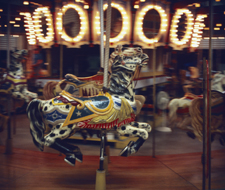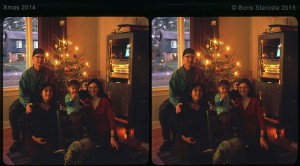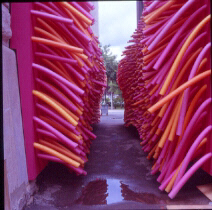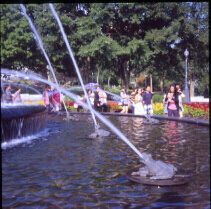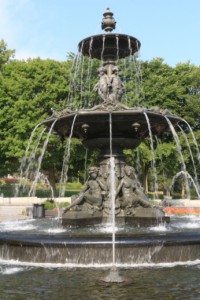Just a few houses down from us is an intersection that I’ve always judged to be hazardous. Melbourne Avenue intersects with Kenwood Lane in a “T” in such a way as to invite sleepy or otherwise impaired motorists onto your property. Melbourne goes over a little rise right before meeting Kenwood on a little steep downhill. The rise prevents a motorist from seeing the stop sign until about the last hundred feet before the intersection. If you don’t know the roads, and you’re going too fast, chances are you’d not be able to stop – especially because coming over the rise your car would be “lifting,” and your traction would be reduced.
To make matters worse, DIRECTLY in the path of Melbourne, i.e. exactly opposite Melbourne, is a house, 1321. When I first saw this arrangement, I immediately thought: I would not want to live in that house; but if I was forced into it, I’d always park some kind of large, heavy, junk car in front of the house. Well, of course the current owners never do that (and amazingly, STILL don’t do it).
So, coming home at night last winter, we noticed a lot of flashing lights just down the road from us. Jet is totally into emergency vehicles, so we went to have a look. I had a peculiar suspicion. Sure enough, an automobile was lodged in the living room of the house opposite Melbourne Ave. Upon coming closer, though, I noticed that it was not 1321 – the house right opposite the intersection – but 1323, the house next to it. The car had come over the rise much too fast and could not stop. The driver had tried to make a left turn, but came nowhere near completing the turn. They jumped the curb, plowed through some bushes, and ended up as you see in the picture, entering the house at a diagonal angle.
 To their great fortune, the family was not at home. I ran back to our house and grabbed the Spud and a tripod. With a policeman’s permission I set up at the corner of the property. I shot a roll exposing between 15 and 30 seconds onto RXP (fuji 400ASA). Local TV and newspaper reporters were there too. In the aftermath the story circulated: this driver had been running from the police, all the way from interstate, outside the city. They had come into town at high speed, taking random turns, ending up at this very unsuitable intersection.
To their great fortune, the family was not at home. I ran back to our house and grabbed the Spud and a tripod. With a policeman’s permission I set up at the corner of the property. I shot a roll exposing between 15 and 30 seconds onto RXP (fuji 400ASA). Local TV and newspaper reporters were there too. In the aftermath the story circulated: this driver had been running from the police, all the way from interstate, outside the city. They had come into town at high speed, taking random turns, ending up at this very unsuitable intersection.
The house has just been repaired, some nine months later. I guess it took a while to get the insurance money straightened out. I’ve not yet talked to the homeowners about the event – I might give them a stereoview sometime as a conversation starter. But I have talked to the neighbors at 1321, where I always thought such a mishap would be the most likely: they were surprised by the event, but remain otherwise not much more concerned than before, still not parking their car in front of their house.
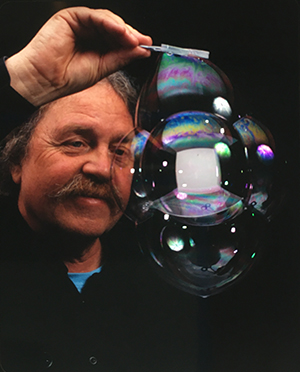
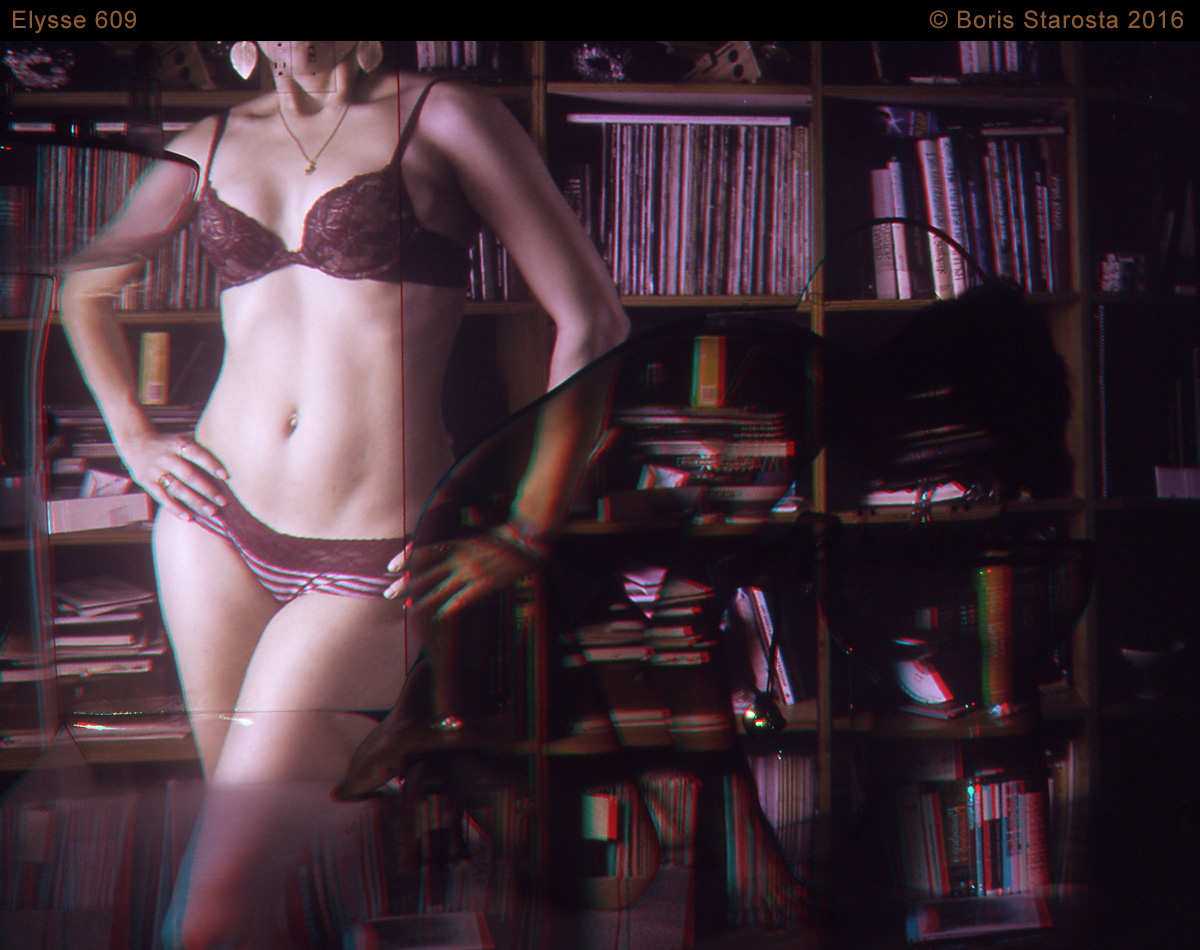 More recent work (in progress). Mixed lighting in studio, Fuji RXP 400, shot with Sputnik. Can you figure this one out?
More recent work (in progress). Mixed lighting in studio, Fuji RXP 400, shot with Sputnik. Can you figure this one out? 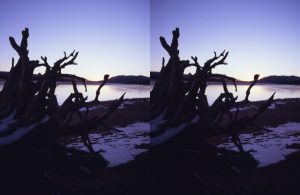
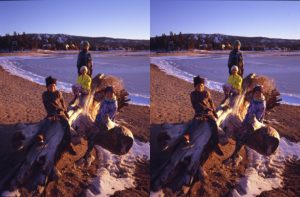
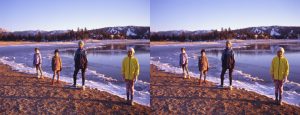
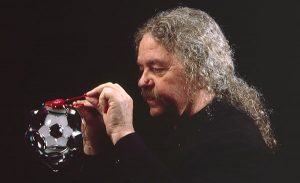
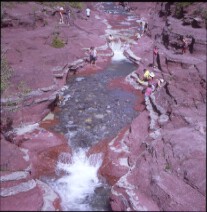 The red rocks provide an unusual background to this otherwise typical scene of people relaxing while enjoying an idyllic scene. The alluvial rocks in the stream bed are not red like the canyon, and have been carried down to the canyon from up the mountain. We fell in love with Waterton Lakes National Park in south-western Alberta during this our first visit. Original slide taken June 7, 2015 with a tripod-mounted Heidoscop using Provia 400X exposed at 1/160 at f16. This was my last roll of Provia 400X; it is sorely missed.
The red rocks provide an unusual background to this otherwise typical scene of people relaxing while enjoying an idyllic scene. The alluvial rocks in the stream bed are not red like the canyon, and have been carried down to the canyon from up the mountain. We fell in love with Waterton Lakes National Park in south-western Alberta during this our first visit. Original slide taken June 7, 2015 with a tripod-mounted Heidoscop using Provia 400X exposed at 1/160 at f16. This was my last roll of Provia 400X; it is sorely missed.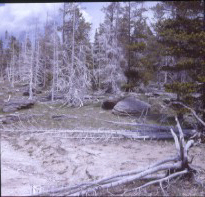 These white dead trees create an otherworldly scene around many of the geysers at Yellowstone. I am not sure why living trees are growing amongst them: are the dead trees silicified and preserved, to be joined by the living trees when they succumb to the harsh environment; or perhaps the conditions have changed allowing a new generation of trees to survive; or perhaps the dead trees were burned in one of the many forest fires that occurred at Yellowstone before being covered in the minerals expelled by the geysers. Original slide taken June 1, 2015 with a tripod-mounted Heidoscop using Provia 400X exposed at an estimated 1/250 at f25.
These white dead trees create an otherworldly scene around many of the geysers at Yellowstone. I am not sure why living trees are growing amongst them: are the dead trees silicified and preserved, to be joined by the living trees when they succumb to the harsh environment; or perhaps the conditions have changed allowing a new generation of trees to survive; or perhaps the dead trees were burned in one of the many forest fires that occurred at Yellowstone before being covered in the minerals expelled by the geysers. Original slide taken June 1, 2015 with a tripod-mounted Heidoscop using Provia 400X exposed at an estimated 1/250 at f25.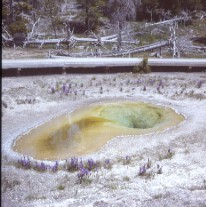 The Belgian Pool was named for a tourist from Belgium who was killed in 1929 after falling into the pool. Enthralled by an eruption of Grand Geyser, the unfortunate man apparently wasn’t watching where he was stepping. The range of colors is caused by the variation in the composition of the microbial mats caused by the change in temperature at different parts of the pool. (The colors would have been more intense with polarizing filters but I don’t have two polarizing filters. This more intimate scene is more effective with the regular lense separation of the Heidoscop than the shots I did of Old Faithful and other majestic scenes in Yellowstone and the Grant Tetons, most of which would have benefited from hyper stereo.) Original slide taken June 1, 2015 wit ha tripod-mounted Heidoscop using Provia 400X exposed at 1/200 at f22.
The Belgian Pool was named for a tourist from Belgium who was killed in 1929 after falling into the pool. Enthralled by an eruption of Grand Geyser, the unfortunate man apparently wasn’t watching where he was stepping. The range of colors is caused by the variation in the composition of the microbial mats caused by the change in temperature at different parts of the pool. (The colors would have been more intense with polarizing filters but I don’t have two polarizing filters. This more intimate scene is more effective with the regular lense separation of the Heidoscop than the shots I did of Old Faithful and other majestic scenes in Yellowstone and the Grant Tetons, most of which would have benefited from hyper stereo.) Original slide taken June 1, 2015 wit ha tripod-mounted Heidoscop using Provia 400X exposed at 1/200 at f22.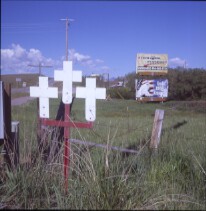 Do these three crosses stand in memory of three people that lost their lives at this lonely crossroads? If yes, what complex lives are reduced to these simple white crosses? What happened? This shot was taken at intersection of US 287 and MT 200, north of Wolf Creek, Montana. The crosses are not present in Google streetview from June 2009. Original slide shot June 6, 2015 with a tripod-mounted Heidoscop using Provia 400X exposed at 1/160 at f25. (I was going to call the image “God Bless Ame”, after the billboard, but changed my mind as I felt it was going to change my intent.)
Do these three crosses stand in memory of three people that lost their lives at this lonely crossroads? If yes, what complex lives are reduced to these simple white crosses? What happened? This shot was taken at intersection of US 287 and MT 200, north of Wolf Creek, Montana. The crosses are not present in Google streetview from June 2009. Original slide shot June 6, 2015 with a tripod-mounted Heidoscop using Provia 400X exposed at 1/160 at f25. (I was going to call the image “God Bless Ame”, after the billboard, but changed my mind as I felt it was going to change my intent.)